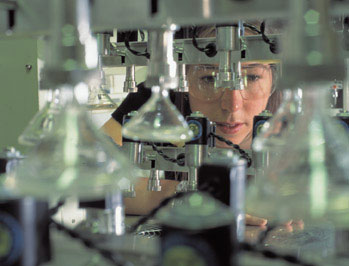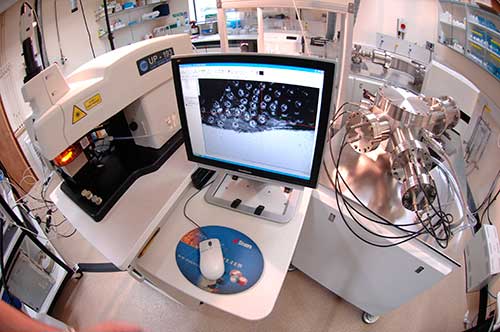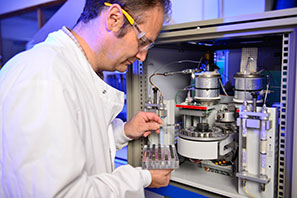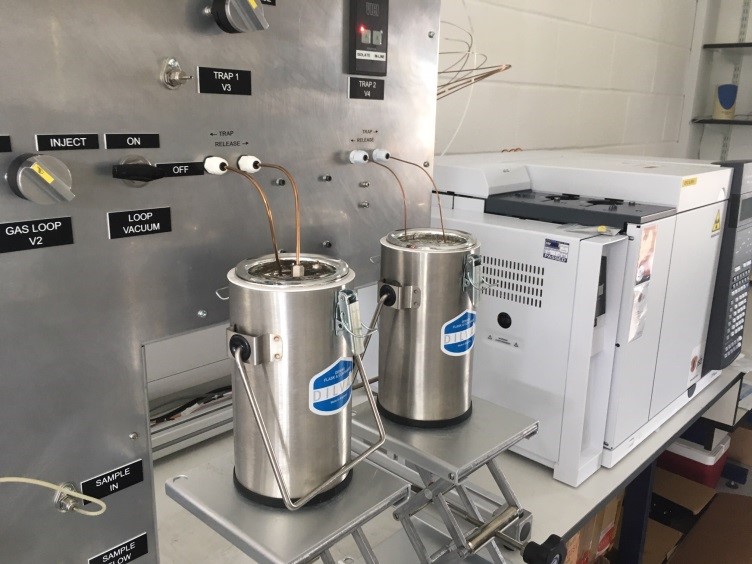Analytical facilities at BGS which form part of the Centre for Environmental Geochemistry
Stable Isotope Facility

Head: Professor Melanie Leng
Equipment and capabilities:
- Elementar isoprime visION with vario PYRO cube for analysis of nitrogen and sulphur compounds: 15N/14N, 34S/32S, and 18O/16O of nitrate, ammonium, sulphate, sulphide and organic nitrogen and sulphur as well as 2H/1H, 13C/12C, 15N/14N, 18O/16O, and 3S/32S of bulk organic materials (plants, soils, sediments, etc.)
- Elementar isoprime precisION with vario ISOTOPE cube for analysis of 13C/1C, 15N/14N and C/N of bulk organic materials (plants, soils, sediments etc.)
- Elementar isoprime precisION with iso FLOW for analysis of 13C/12C of aqueous bicarbonate
- GV IsoPrime with EuroPyrOH for analysis of water 2H/1H in marine and fresh waters, fluid inclusions and soil/plant materials
- GV IsoPrime with MultiCarb for analysis of 13C/12C and 18O/16O of microfossil and other pure calcium carbonates
- IsoPrime100 with MultiCarb for analysis of 13C/12C and 18O/16O of micro carbonates
- IsoPrime100 with AquaPrep for analysis of water 18O/16O in marine and fresh waters, fluid inclusions and soil/plant materials
- Sercon HS2002 with CyroGas for the analysis of 13/C/12C and 2H/1H of methane (and 13C/12C of CO2) from high to atmospheric concentrations in both gas and water samples
- Thermo Delta V with EA IsoLink for very high precision analysis on a variety of matrices for 18O/16O, D/H, 13C/ 12C, 15N/14N, 34S/32S on small sample sizes at high precision
- Thermo Finnigan MAT 253 with Manifold for analysis of 18O/16O and 30Si/28Si of rock minerals, biogenic silica and tooth/bone materials
- VG Optima with Manifold for analysis of 13C/12C and 18O/16O of impure carbonates and aqueous bicarbonate
More about Stable Isotope Facility
Inorganic Geochemistry Facility

Head: Dr Michael Watts
Equipment and capabilities:
- inductively coupled plasma optical emission spectrometry (ICP-OES) and inductively coupled plasma mass spectrometry (ICP-MS) instrumentation for the analysis of a comprehensive suite of major and trace elements. This includes ultra-trace detection limits (ng/l) for a range of elements in natural waters by ICP-MS. The ICP-MS facilities also include: laser ablation capability for the spatial analysis of solids on a micrometer scale, isotope-ratio measurement capability (e.g. uranium isotopes), element speciation capability using high pressure liquid chromatography ICP-MS (HPLC-ICP-MS), including investigation of arsenic and chromium species. Mercury analyser for analysis in various matrices. 210Pb analysis of peats and sediments using gamma spectrometry.
- ion chromatography for analysis of anions
- potentiometric titration for analysis of pH in waters and soils, and alkalinity in water
- potentiometry for analysis of electrical conductivity
- organic carbon analyser for non-purgeable organic carbon (NPOC)
- 210Pb dating facility
More about Inorganic Geochemistry Facility
Organic Geochemistry Facility

Head: Dr Christopher Vane
Equipment and capabilities:
- Rock–Eval(6) pyrolyzer for assessment of organic matter quality, maturity and source (16 parameters including TOC, HI, OI, RC, Tmax, MinC). Rock-Eval(6) carbon stability measurement of peats, soils and marine sediments as well as urban and agricultural soils.
- Liquid Chromatography-Mass Spectrometry(UHPLC-MS/MS Thermo Quantiva) for emerging pollutants (pharmaceuticals, hormones, personal care products, pesticides) and tetraether lipids (GDGT) to track environmental change.
- Gas Chromatography–Mass Spectrometry (GC/MS/MS Thermo TSQ 9000) for the measurement of pollutants in Brownfield soils, urban run–off and rural catchments. Suites include, polyaromatic hydrocarbons (>30 parent and alkylated PAH), polychlorinated biphenyls (>30 PCB congeners including dioxin like forms), fire retardants (PBDE), organo–chlorines (DDT, DDE, HCH, Endrin) and faecal steroids (~30 stanols and sterols) to trace sewage treatment and animal input.
- TOC analyser (Elementar–VarioMax) for TOC and TC % and Black Carbon.
- Iatroscan(Mk6) for determination ofsaturate, aromatic, resins and asphaltenes (SARA).
- Gas–Chromatography for quantification of n–alkanes, fatty acids and levoglucosan.
- Mid–Infrared Spectroscopy (FTIR) (BioRad) for characterisation of organic and mineral matter in peats, rural and urban soils, rock core and assessment of microplastics.
- Microtox Bioassay Analyser for toxicity of coastal/river sediments and waters.
- Dermal Bioaccessibility tests transfer of pollutants from soil to the human body via skin.
- Analytical Pyrolysis (CDS 2000) – GC/MS for molecular characterisation of polymeric natural organic matter (kerogens, coals, woods, peats) and anthropogenic materials such as microplastics.
More about Organic Geochemistry Facility
Dissolved Gases Facility

Head: Professor Daren Gooddy
Equipment and capabilities:
- 2 Agilent Gas Chromatographs fitted with electron capture detectors (GC–ECD) fitted with bespoke purge and trap systems (P&T) for analysis of groundwater residence time indicators CFC–11, CFC–12, Sulphur Hexafluoride (SF6) and Halon 1301
- Agilent Gas Chromatograph fitted with Thermal Conductivity Detector (GC–TCD) and Flame Ionisation Detector (GC–FID) for simultaneous measurement of CH4 and CO2 in groundwaters
- Agilent Gas Chromatograph fitted with electron capture detector for measurement of N2O in surface and groundwaters
- Pfeiffer PrismaPlus Quadrupole Mass Spectrometer for measurement of Noble Gases He, Ne, Kr and Xe in waters
